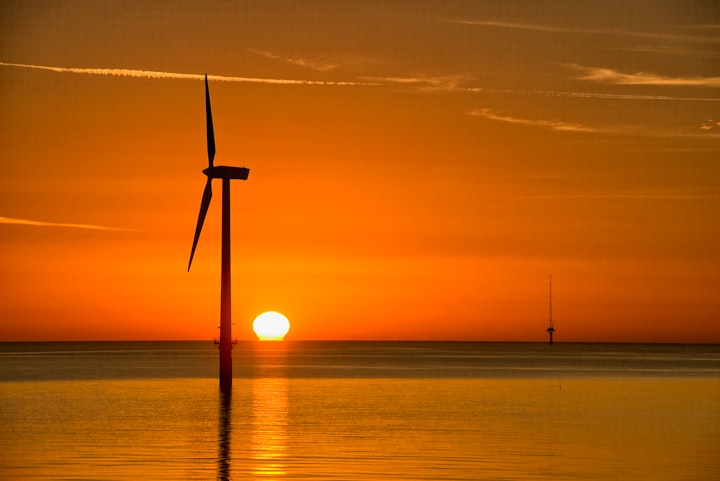Climate change: why isn't government putting its money where their mouth is?

Let’s begin with a question. How much would you say governments around the developed world spend on research into energy? They certainly talk about it rather a lot, from Joe Biden to Boris Johnson (and for that matter from Barack Obama to David Cameron) they have talked continually about preparing their economies for a greener, more efficient future.
So perhaps you assumed that they would have been spending more than ever before on this kind of stuff. I did… surely, I figured, they’re putting their money (or rather our money) where their mouth is and spending more on funding the science that would help power the future? Then I looked at the numbers.
In fact, it turns out that far from spending more on this stuff than ever before, our governments are spending considerably less on energy research than they were in the 1980s and early ‘90s. Far from being at a high point now the high water mark for energy R&D was in 1980. You get a sense of it from the chart above, which shows you the percentage of R&D spent on energy since 1974.
“But ah!” you’re probably thinking. Surely that chart is massively distorted by all the money we were spending back then in the early 1980s on fossil fuels - after all, the story of the late 1970s was all about western nations spending lots of money finding alternative sources of oil following the energy shock of the 1970s (viz the North Sea and the Gulf of Mexico). And you’re half right: a lot of the spending back then was indeed on fossil fuels. But actually a surprising amount, even back then, was on renewable energy. Consider:
This chart (a kind of sub-chart to chart no.1 above, rather than the second one you really need to know about) shows you government research and development on renewable energy. And look! Again, developed economies - the very ones who make the most noise about greenifying the power system and increasing our reliance on renewable energy, are spending less as a percentage of GDP than they did in the late 1970s. Less, for that matter, than they did a decade ago.
Now of course public investment is only one part of the story, comprising about a third of the total. But given the amount they have talked in recent years about climate change, and given they help shape the incentives for the rest of us (more on this below), the trends are not especially encouraging.
I am not sure why we’re not all talking much more about this chart. Perhaps it’s because it’s so rarely published, which owes more than a little to the fact that the International Energy Agency, which produces this data, keeps most of its data behind a paywall. In this case the data underlying these charts was actually downloadable - click on the “selected data” link here.
Perhaps we don’t talk about it as much because there has indeed been considerable technological advance in renewable energy. The price of solar panels has dropped enormously, though disaggregating how much of this is down to technological advances as opposed to cheap Chinese labour in Xinjiang, or for that matter cheap Chinese coal which powers the solar supply chain, is not easy.
Perhaps it’s because it hasn’t yet dawned on either policymakers or the public the extent to which getting to net zero (and then staying there) is about both economics and technology. It is about incentives and about invention. Why? Because for the first time, well, ever, humankind is stepping down the energy density ladder, aiming to maintain our lifestyles while relying on power sources which are considerably less energy-rich than the coal, oil and gas which currently power the world.
Whichever it is, it’s hard not to conclude that the amount we are spending on research into new sources of energy is oddly, alarmingly, depressingly low. Which brings me to the second most important chart you’ll see today.

This data - again from the annoyingly opaque but annoyingly good IEA database - shows you how they, and by extension most western governments around the world, expect we’ll get our greenhouse gas emissions down to net zero by 2050. A few notable things: first, look how small the purple slices are: no-one really expects this all to happen via behavioural change, in other words people flying less or eating less meat or recycling more. Yes it’s a factor, but not a big factor. You can mark this down as defeatist or realist, but fair enough.
The real thing I want to draw your attention to is the yellow chunk. That yellow chunk denotes the share of carbon reduction we’re expecting to come from stuff you can’t buy today. Think about it for a second. We’re expecting nearly half of all the carbon reductions by 2050 to come from technologies that aren’t yet perfected, the stuff that’s never been done at scale before. The stuff, in other words, that we seriously need to spend some time and money researching. Which is where the stories of these charts intersect.
We are spending less on research than we did in the 1980s. Yet we are expecting that research, that pared-back research, to get us nearly half the way to the net zero targets our politicians spend so much time talking about. This is, frankly, bonkers. Which is why you need to keep these charts at the top of your minds in the run up and the aftermath of the COP26 summit in Glasgow this autumn.
It’s all very well setting out plans to eliminate net zero. The UK, for what it’s worth, has been bolder and more transparent about this stuff than most of its counterparts. And so much of COP will probably be devoted to talk about plans on where carbon reduction is coming from. But that stuff is all meaningless until the policymakers can explain and reconcile the charts above. Who is going to pay for all the technology which will supposedly save us?
Those UK plans on getting to net zero depend in no small part on a technology called carbon capture and storage. CCS is one of those topics which gets far less attention than it should, given there it is hard to imagine getting to net zero without it. Over the past few weeks I’ve been working on a set of pieces - a film and a long read - about CCS. You can read the long read here, and the film is below:
The overarching point is that none of the five scenarios mapped out by the Climate Change Committee on how Britain gets to net zero actually got there without carbon capture. And yet… as of this moment CCS has never been achieved at scale anywhere in the world. We’re still on pilot projects.
It is hard to think of another topic or issue in the climate debate that is both as crucial and yet as under-discussed and debated as CCS. Quite why this is I don’t know. Perhaps it’s because it’s one of those issues which everyone feels ambivalent about: for purists, it seems like a cop-out since it validates further burning of fossil fuels. It is a technology which has promised enormous amounts but has failed, so far, to deliver.
Most of all, it’s a technology which governments have been reluctant so far to get behind in a big way. That may change, to some extent, this week since the UK’s Department for Business, Energy and Industrial Strategy (BEIS) is poised to approve funding for some CCS schemes around the country. Yet everyone in the sector is well aware that government has talked a good game about this before, and then shelved schemes and canned funding at the last minute. So we’ll see.
Either way, keep this all in the back of your heads in the coming weeks. We’re about to be deluged by promises and pledges, by big numbers and, for that matter, big critiques. But keep these charts in mind.




Comments ()